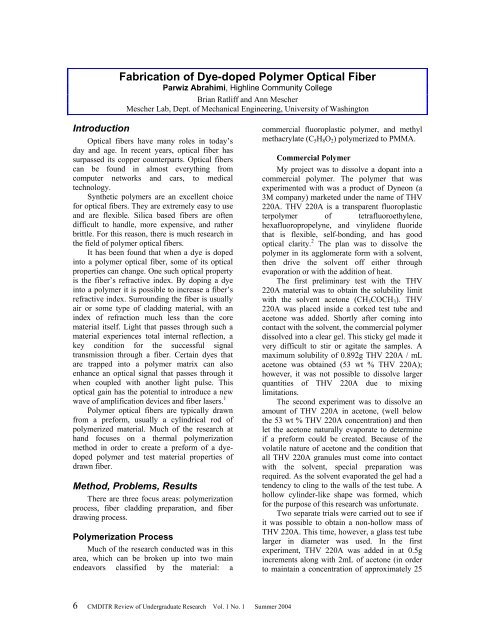CMDITR Review of Undergraduate Research - Pluto - University of ...
CMDITR Review of Undergraduate Research - Pluto - University of ...
CMDITR Review of Undergraduate Research - Pluto - University of ...
Create successful ePaper yourself
Turn your PDF publications into a flip-book with our unique Google optimized e-Paper software.
Fabrication <strong>of</strong> Dye-doped Polymer Optical Fiber<br />
Parwiz Abrahimi, Highline Community College<br />
Brian Ratliff and Ann Mescher<br />
Mescher Lab, Dept. <strong>of</strong> Mechanical Engineering, <strong>University</strong> <strong>of</strong> Washington<br />
Introduction<br />
Optical fibers have many roles in today’s<br />
day and age. In recent years, optical fiber has<br />
surpassed its copper counterparts. Optical fibers<br />
can be found in almost everything from<br />
computer networks and cars, to medical<br />
technology.<br />
Synthetic polymers are an excellent choice<br />
for optical fibers. They are extremely easy to use<br />
and are flexible. Silica based fibers are <strong>of</strong>ten<br />
difficult to handle, more expensive, and rather<br />
brittle. For this reason, there is much research in<br />
the field <strong>of</strong> polymer optical fibers.<br />
It has been found that when a dye is doped<br />
into a polymer optical fiber, some <strong>of</strong> its optical<br />
properties can change. One such optical property<br />
is the fiber’s refractive index. By doping a dye<br />
into a polymer it is possible to increase a fiber’s<br />
refractive index. Surrounding the fiber is usually<br />
air or some type <strong>of</strong> cladding material, with an<br />
index <strong>of</strong> refraction much less than the core<br />
material itself. Light that passes through such a<br />
material experiences total internal reflection, a<br />
key condition for the successful signal<br />
transmission through a fiber. Certain dyes that<br />
are trapped into a polymer matrix can also<br />
enhance an optical signal that passes through it<br />
when coupled with another light pulse. This<br />
optical gain has the potential to introduce a new<br />
wave <strong>of</strong> amplification devices and fiber lasers. 1<br />
Polymer optical fibers are typically drawn<br />
from a preform, usually a cylindrical rod <strong>of</strong><br />
polymerized material. Much <strong>of</strong> the research at<br />
hand focuses on a thermal polymerization<br />
method in order to create a preform <strong>of</strong> a dyedoped<br />
polymer and test material properties <strong>of</strong><br />
drawn fiber.<br />
Method, Problems, Results<br />
There are three focus areas: polymerization<br />
process, fiber cladding preparation, and fiber<br />
drawing process.<br />
Polymerization Process<br />
Much <strong>of</strong> the research conducted was in this<br />
area, which can be broken up into two main<br />
endeavors classified by the material: a<br />
commercial fluoroplastic polymer, and methyl<br />
methacrylate (C 5 H 8 O 2 ) polymerized to PMMA.<br />
Commercial Polymer<br />
My project was to dissolve a dopant into a<br />
commercial polymer. The polymer that was<br />
experimented with was a product <strong>of</strong> Dyneon (a<br />
3M company) marketed under the name <strong>of</strong> THV<br />
220A. THV 220A is a transparent fluoroplastic<br />
terpolymer <strong>of</strong> tetrafluoroethylene,<br />
hexafluoropropelyne, and vinylidene fluoride<br />
that is flexible, self-bonding, and has good<br />
optical clarity. 2 The plan was to dissolve the<br />
polymer in its agglomerate form with a solvent,<br />
then drive the solvent <strong>of</strong>f either through<br />
evaporation or with the addition <strong>of</strong> heat.<br />
The first preliminary test with the THV<br />
220A material was to obtain the solubility limit<br />
with the solvent acetone (CH 3 COCH 3 ). THV<br />
220A was placed inside a corked test tube and<br />
acetone was added. Shortly after coming into<br />
contact with the solvent, the commercial polymer<br />
dissolved into a clear gel. This sticky gel made it<br />
very difficult to stir or agitate the samples. A<br />
maximum solubility <strong>of</strong> 0.892g THV 220A / mL<br />
acetone was obtained (53 wt % THV 220A);<br />
however, it was not possible to dissolve larger<br />
quantities <strong>of</strong> THV 220A due to mixing<br />
limitations.<br />
The second experiment was to dissolve an<br />
amount <strong>of</strong> THV 220A in acetone, (well below<br />
the 53 wt % THV 220A concentration) and then<br />
let the acetone naturally evaporate to determine<br />
if a preform could be created. Because <strong>of</strong> the<br />
volatile nature <strong>of</strong> acetone and the condition that<br />
all THV 220A granules must come into contact<br />
with the solvent, special preparation was<br />
required. As the solvent evaporated the gel had a<br />
tendency to cling to the walls <strong>of</strong> the test tube. A<br />
hollow cylinder-like shape was formed, which<br />
for the purpose <strong>of</strong> this research was unfortunate.<br />
Two separate trials were carried out to see if<br />
it was possible to obtain a non-hollow mass <strong>of</strong><br />
THV 220A. This time, however, a glass test tube<br />
larger in diameter was used. In the first<br />
experiment, THV 220A was added in at 0.5g<br />
increments along with 2mL <strong>of</strong> acetone (in order<br />
to maintain a concentration <strong>of</strong> approximately 25<br />
6 <strong>CMDITR</strong> <strong>Review</strong> <strong>of</strong> <strong>Undergraduate</strong> <strong>Research</strong> Vol. 1 No. 1 Summer 2004




